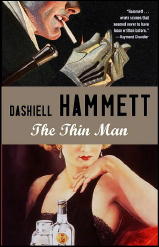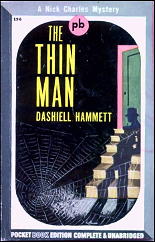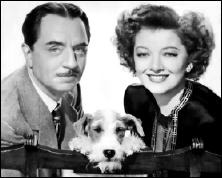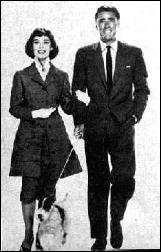Mon 21 Sep 2009
A 1001 MIDNIGHTS review: DASHIELL HAMMETT – The Thin Man.
Posted by Steve under 1001 Midnights , Reviews1 Comment
by Bill Pronzini:
DASHIELL HAMMETT – The Thin Man. Alfred A. Knopf, 1934. Reprinted many times, in both hardcover and paperback, including Pocket #196, 1942; Vintage, trade pb, 1989.

The Thin Man is Hammett’s last and weakest novel. By the time it was written, he had begun his affair with Lillian Hellman, been embraced and financially enriched by Hollywood, and adopted a freewheeling, alcoholic, pseudo-sophisticated life style not dissimilar to the one depicted in these pages.
He had, in short, lost touch with everything that had made his earlier work so innovative and powerful — his background as a Pinkerton detective, his contacts in the underworld, the lean years spent in a San Francisco flat painstakingly writing stories for Black Mask.
Hammett could not go home again, and he knew it. Unable to write about the Op or Sam Spade, he could only write about the likes of Nick and Nora Charles. They were phonies in comparison, and he knew that, too — if not during the composition of The Thin Man, then not long afterward.

Nick Charles is no longer a detective, a reflection of the fact that Hammett was no longer a writer; he is an ex-sleuth, formerly with the Trans-American Detective Agency of San Francisco, having one last fling at his old profession. Nor is he tough any longer; he is a charming, fun-loving, nouveau riche alcoholic with a veneer of gentility.
(His wife is just like him, the flighty type who forces him into his one last fling as a means of exorcising her own boredom — the kind of woman the Op or Sam Spade would have sneered at in the old days.)
The plot has its moments, but on the whole it is merely a standard whodunit of the period. Inventor Clyde Wynant disappears and his secretary is found murdered; Nick investigates at Nora’s urging and encounters such characters as Mimi Jorgensen (his former girlfriend), Dorothy Wynant (Mimi’s daughter), a crooked lawyer named Herbert Macaulay, a gangster named Shep Morelli, a nightclub owner named Studsy Burke.

There is more mayhem, considerable duplicity, and enough booze consumed to float the proverbial battleship; Nick solves the case; and at the end Nora says, “Let’s stick around San Francisco a while. This excitement has put us behind in our drinking.”
Those two lines are typical of the book’s tone: light, witty, urbane. If anyone other than Hammett had written it, it would stand as an amusing piece of fluff. But compared to The Dain Curse, The Maltese Falcon, and The Glass Key, it is shallow and gutless.
Ironically, Nick and Nora Charles, thanks to the six films starring William Powell and Myrna Loy, join Sam Spade as Hammett’s most famous detective characters. The films, like the novel, are witty and sophisticated; unlike the novel, they work well because Hammett didn’t write them and because of the delightful interplay between Powell and Loy.

The best are the first, The Thin Man (1934), based on the novel; After the Thin Man (1936); and Shadow of the Thin Man (1941). Peter Lawford starred in a popular TV series in the Fifties.
It should also be noted that Hollywood is responsible for the widespread misconception that “the thin man” refers to Nick Charles. Not true. It refers to the disappearing inventor, Clyde Wynant.
———
Reprinted with permission from 1001 Midnights, edited by Bill Pronzini & Marcia Muller and published by The Battered Silicon Dispatch Box, 2007. Copyright © 1986, 2007 by the Pronzini-Muller Family Trust.
Note: This completes this cycle of Hammett reviews on the Mystery*File blog, which began with Dan Stumpf’s earlier comments on The Thin Man, which you can find here.
September 25th, 2017 at 12:33 am
Hmm. “The films , , . work well because Hammett didn’t write them”. Yet he wrote the screenplay for “After the Thin Man”, which is praised here. As one of Hammett’s dumb bad guys would have said, “huh?”